A side-scrolling 2.5D horror, Sense: A Cyberpunk Ghost Story is coming to Nintendo Switch. Is there room for ghosts in the digital age? The Finger Guns Review:
We are still in the wake of a much larger Cyberpunk and all the fallout that it has caused, but let’s not forget that the dystopian genre of mega-corporations, biotech, glitches and hacking is also the most popular thing around right now. Releasing a little indie ghost story into that maelstrom sounds a little foolhardy, but on the other hand, maybe it’s inspired, as gamers clamor for more cyberpunk genre content to fill our insatiable appetites.
Sense: A Cyberpunk Ghost Story knows what it’s got without being told. Just setting the game in a cyberpunk world clearly wasn’t enough. Throw in a subtitle with the hottest keyword around and you get into a lot of searches you otherwise would not have been in. Call me cynical. Simultaneously, Sense has also managed to be at the centre of, and mostly self-generate, a censorship controversy around its female character designs being somewhat asset-heavy. It’s a storm in a teacup, but it’s great publicity.
Underneath the cynical subtitle and controversy, the game is at least set in a Neo Hong Kong whose neon will make you feel right at home. But only for a moment. Sense is actually a 2D side-scrolling horror, made up of point and click elements mixed with Resident Evil-style keys, locks and items. The closest thing I could compare it to would be the recent Coma games, which are in turn clearly influenced by the original Clock Tower games. But is it any good? Does it deserve the interest it might get from the cyberpunk fans? Or is this one better off left well alone?
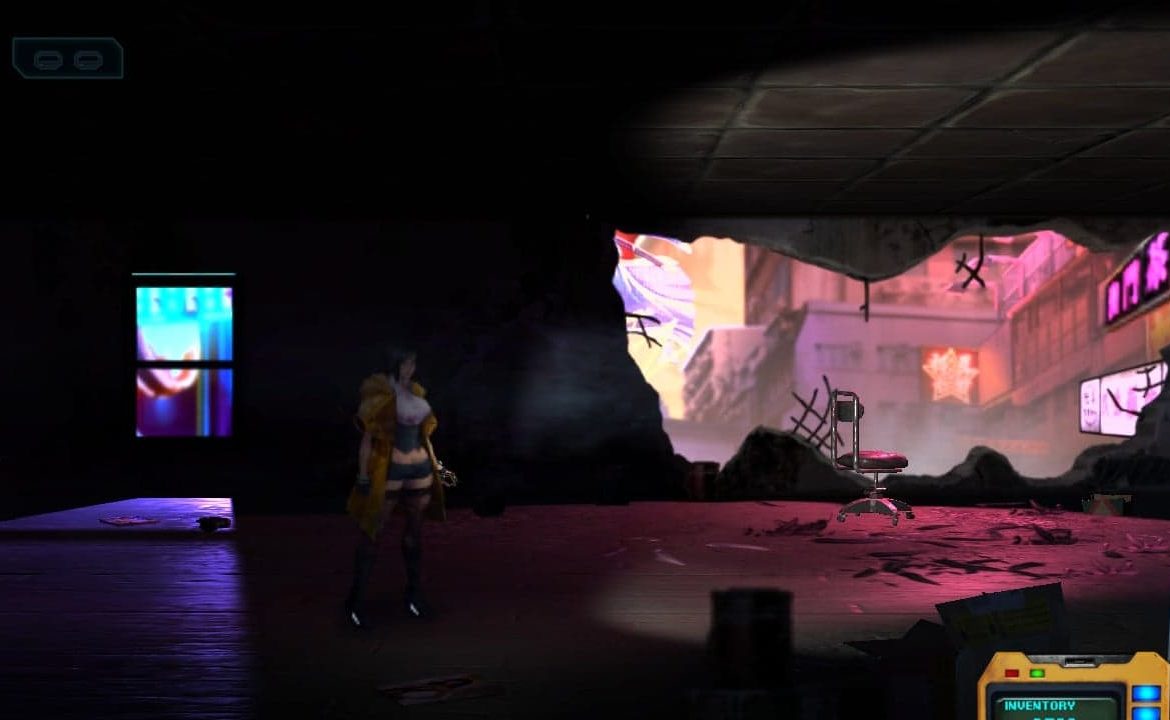
Sense follows a single horror-filled night in the life of Mei, a young woman who accidentally stumbles upon the abandoned Chong Sing apartment block while looking for the privy in a 2083 downtown club. Her cybernetic eyes glitch out and when she can see again, she finds the doors locked and no way out (we have to assume there was no smartphone reception to call friends or the cops). As Mei heads upward looking for a way out, every apartment seems to be the site of a grisly murder, suicide, or haunting, and you soon find the only way to progress is to bring closure to each of the wandering ghosts via burnt offering and exorcism.
Floor by floor, Mei works her way through the building, chased and haunted by ghouls, and an ultimate evil spirit that has cursed them all. It’s a single-building closed horror, really similar in style to the Clock Tower games. The trouble with the cyberpunk angle is that beyond the first ten minutes in a futuristic club, and a few minutes at the end, you will spend the majority of the 6-8 hours playtime running from one end to the other of a dark, rundown, abandoned building investigating deaths that happened 100 years earlier. That’s the whole game. Beyond a glitch in Mei’s eye hardware that lets her see the ghosts, there’s almost no need for it to be cyberpunk at all.
If you are going in thinking you are getting a ‘cyberpunk ghost story’, I think you’re going to be pretty disappointed. What you are really getting is an Asian-flavoured horror, that is incredibly close to the Coma games in gameplay, tone, atmosphere, and style. The cyberpunk elements could all have been dropped from the narrative without there being any noticeable difference to the game. In fact it probably would have made more sense overall to set it in present day, and have the deaths be 100 years ago. I think it’s somewhat disingenuous to advertise a game in this way, when there is a perfectly viable Asian-horror market to tap. It’s a trade-off: advertise to a large, but disappointed cyberpunk market, or a smaller Asian horror market, who would be more satisfied with the product?
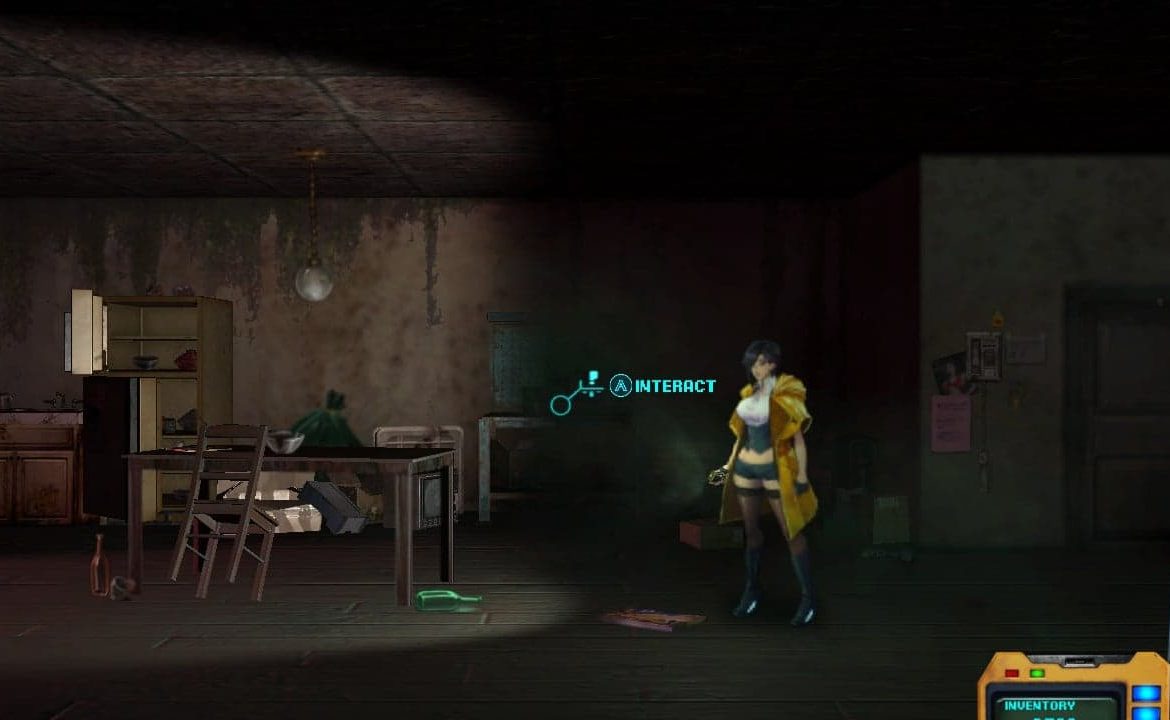
The structure of the game is simple – search each room and apartment in the building for items: keys, stamps, letter openers, and clues for combination locks, all of which are your barrier to the next door, to the next room full of keys and locks and clues. Take this key here, unlock this, find a new item, that unlocks something different. We’ve seen this gameplay loop a hundred times, and though it’s retro and familiar which can take it quite some way, it’s also pretty dull.
Sense has a slight issue in that you cannot pick up most items until you’ve discovered the corresponding lock that needs them. This can prove frustrating as you are constantly forced to go back and forth, discovering a new lock, finding the relevant item and then discovering yet another lock just a few steps beyond that. You’ll need to check everything more than once, lots of things change to being useful the second or third time you get to them.
Keys and locks and items that take you to the next area are all fine, and won’t generally cause too much trouble – the game is not that difficult. Except that is, in the combination locks. There’s one or two per floor and there’s 6 floors to work your way through, and some of the clues to the combinations are cryptic beyond belief. I found more than one where the solution made no sense to me even after I’d eventually found it, and some that needed to be back-to-front, but never even gave you a hint that was the case.
At the end of each floor, and sometimes more than once, you are required to burn an offering to appease and exorcise the ghosts, and these can’t be done without finding basically every single clue to their story and how they died. Once achieved though, this ‘completion’ of each floor was satisfying.
Lastly there’s the combat. On the first few floors you just have to run and hide from ghosts, and you are given barely anywhere to hide, unlike in Coma 2 where hiding places exist in every room and corridor. If the ghost does get you, they generally just break a jade bangle you have hopefully collected, giving you a second chance. One of the ghosts also steals items, which can be really frustrating until you realise where all your items have got to.
You find a sword someway in, but actual combat is really badly implemented, giving you no real idea if you’ve hit an enemy or not, and barely any control. It’s a case of swing madly and hope you hit something and it’s up there with the worst combat I’ve played, but thankfully is only really needed a handful of times.
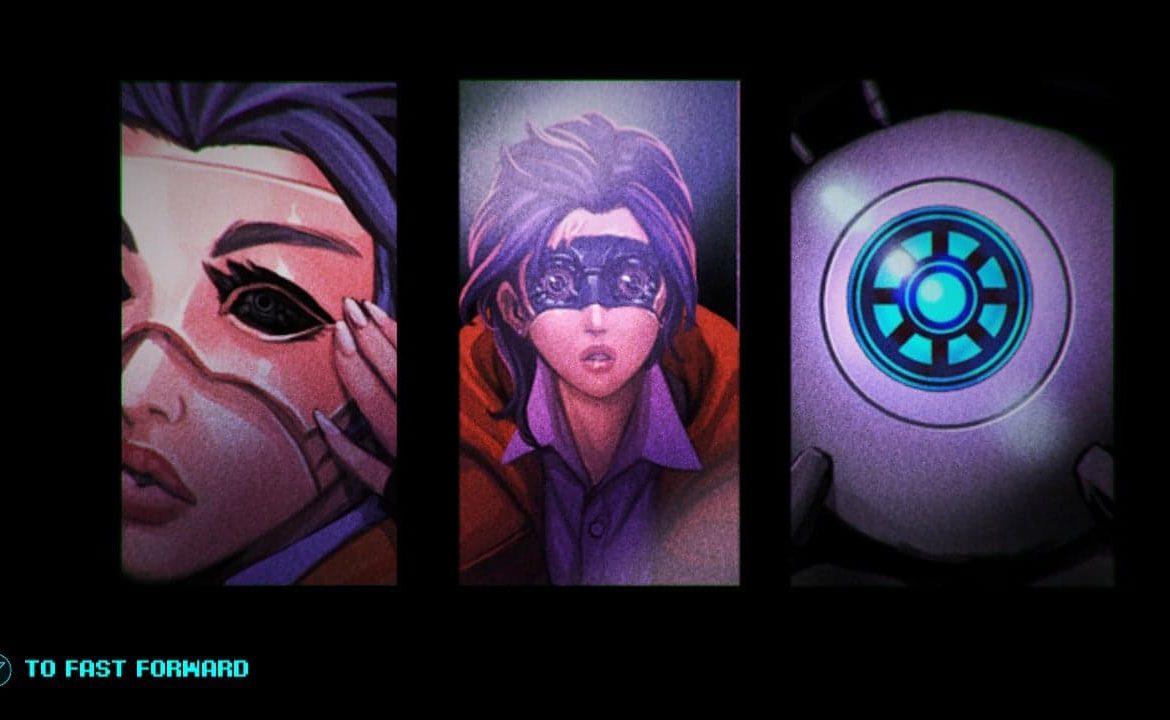
A successful kickstarter in 2018, Sense managed to smash it’s $10k goal, achieving $60k from backers. The Kickstarter leans heavily into the cyberpunk artwork and manages not to mention that the vast bulk of the game is in very dark abandoned room locales, or that the cyberpunk locations form barely twenty minutes of the game. It was also sold on it’s ‘enhanced’ character designs, inspired they say, by Chifumi Suzuki, famous for the infamously top-heavy Dead or Alive characters. These have become the subject of a tiny amount of controversy online, accusing the game of explicit content, enough that TopHatStudios stoked the flames for publicity and put out a CD Projekt Red style disclaimer, announcing that they would never be censoring the game. Good, you don’t need to.
Because there’s nothing to censor. Sense certainly has a fair bit of cutscene and NPC artwork in it with unfeasibly large assets, but there is never a single bit of the game that showed anything of a pornographic nature. It’s not AO, erotic, or R-rated. Based on the content of the game it earns its PEGI 18 rating in the UK mostly for some gory dead bodies and grisly deaths in cutscene, rather than any nudity.
Art in Sense is split into three different types; backdrops, character/NPCs and cutscenes. The pre-rendered backdrops and locations in Sense are very basic and very dark – using your torch helps a lot more than the brightness setting which does almost nothing. Character and NPC art leaves a lot to be desired, and the animation is on the rudimentary side, looking very much like it’s been constructed of a few individual pieces held together by drawing pins. Cutscenes are made up of comic-style static cells, many with some level of very basic movement to them. They serve to tell the story, but they fail to create any dramatic tension.
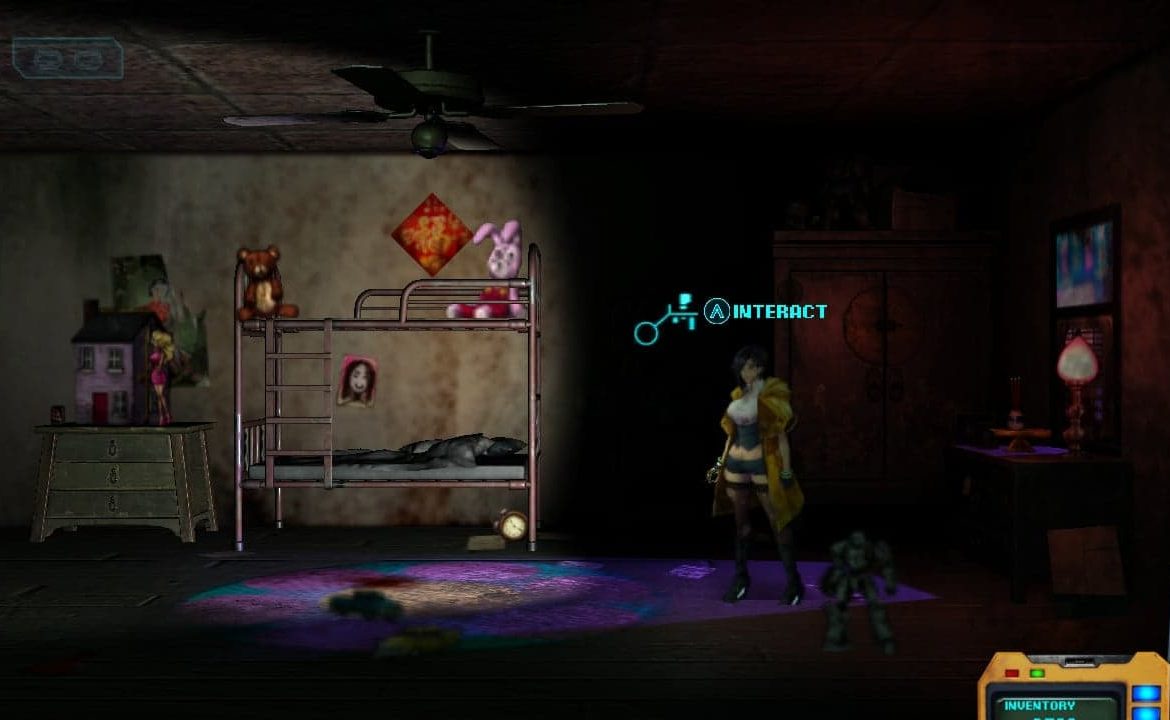
There is little music in Sense, just a few ambient horror tracks and one or two cyberpunk ones at the beginning and end. When tracks do start, they often restart again on every new screen, meaning you get to listen to the first 20 seconds over and over again.
The game isn’t especially glitchy on Switch, but I did run into one crash that sent me reeling back to the Nintendo home screen. It only happened the once, and if anything was just a reminder to save often and a lot. Which brings me neatly to the save system, of which Sense has two. One is Betamaxx tapes (that’s 80s not cyberpunk) which are treated much like the typewriter ribbons on Resident Evil, allowing you to save at a couple of tape players – about one per floor. However there’s only a half dozen tapes in the game, making saving a very costly mechanic.
In light of this, and probably to reduce that punishing difficulty, there is a second ‘quick save’ option. Just open the menu and save, anywhere, at any time. Usually a quick save function means you will need to ‘real’ save before you turn off the system. Quick save in Sense is not like this, they count as real saves – turn off the Switch fully or sleep mode, whatever, the save is still there. So in fact these two save functions act more like two difficulty levels, normal (infinite saves) and hard (close to 6 saves total).
You will want to save a lot, because Sense has a number of places where you can get a game over and lose that progress just by picking up or using the wrong item or interaction. Think you can make that jump, try it. You’re dead, instantly. Use that sink, whoops, you’ve cut your hands off. Game Over. No warning. Well, I mean, apart from this warning.
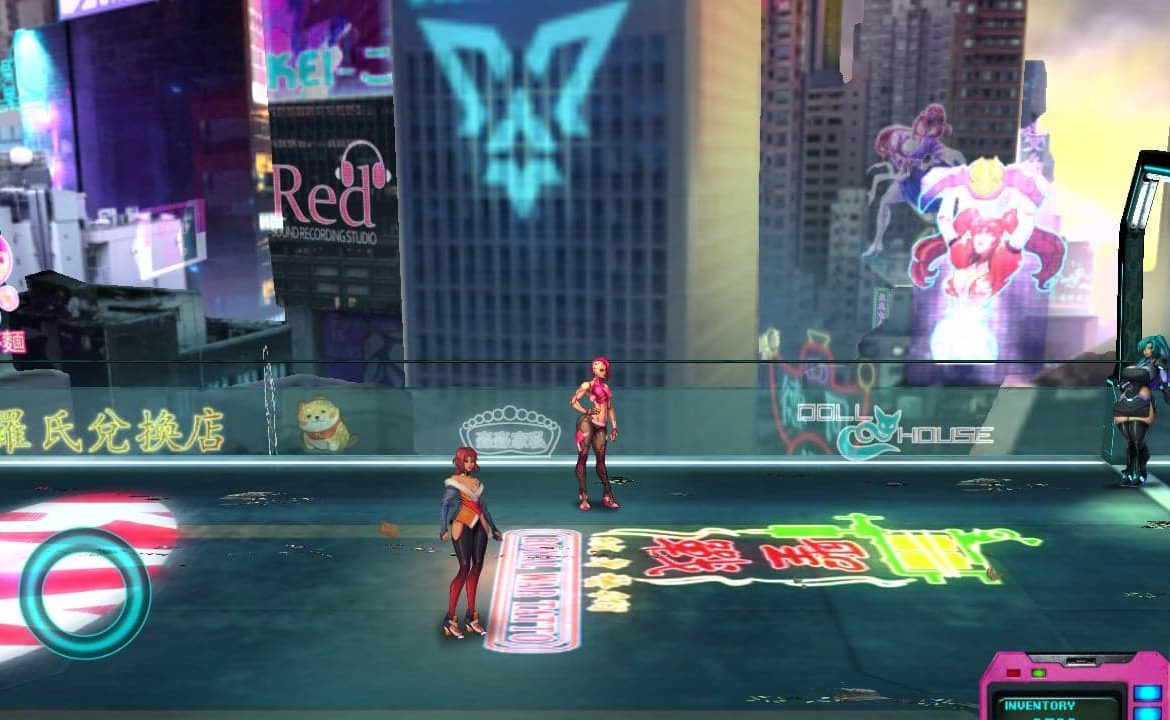
Sense: A Cyberpunk Ghost Story is not a bad game, it’s just average. There’s no real ambition to do something we haven’t seen before, or to realise any of its elements to their fullest potential. That said you can have fun with Sense, if you go in expecting a horror ghost story about finding keys and exorcising spirits, rather than expecting high levels of polish or cyberpunk themes of any tangible kind. It’s by the numbers, literally from apartment room to apartment room.
It feels like a cynical marketer realised you could add a scene of cyberpunk at the beginning and end and make her eyes glitchy, and then you can sell a horror game off as a cyberpunk game. But regardless of its cyberpunk or horror content, it’s a budget release that never rises to the levels of its clear inspiration.
For a game about spirits, Sense: A Cyberpunk Ghost Story is pretty soulless. A by-the-numbers backtracking horror game in the vein of Clock Tower, it’s structure and content feel lacklustre and a little disappointing if you went in expecting cyberpunk themes.

Sense: A Cyberpunk Ghost Story is available now on Nintendo Switch (review platform) and PC via Steam.
Developer: Suzaku, Top Hat Studios
Publisher: eastasiasoft
Disclaimer: In order to complete this review, we were provided with a promotional copy of the game. For our full review policy, please go here.
If you enjoyed this article or any more of our content, please consider our Patreon.
Make sure to follow Finger Guns on our social channels –Twitter, Facebook, Twitch, Spotify or Apple Podcasts – to keep up to date on our news, reviews and features.
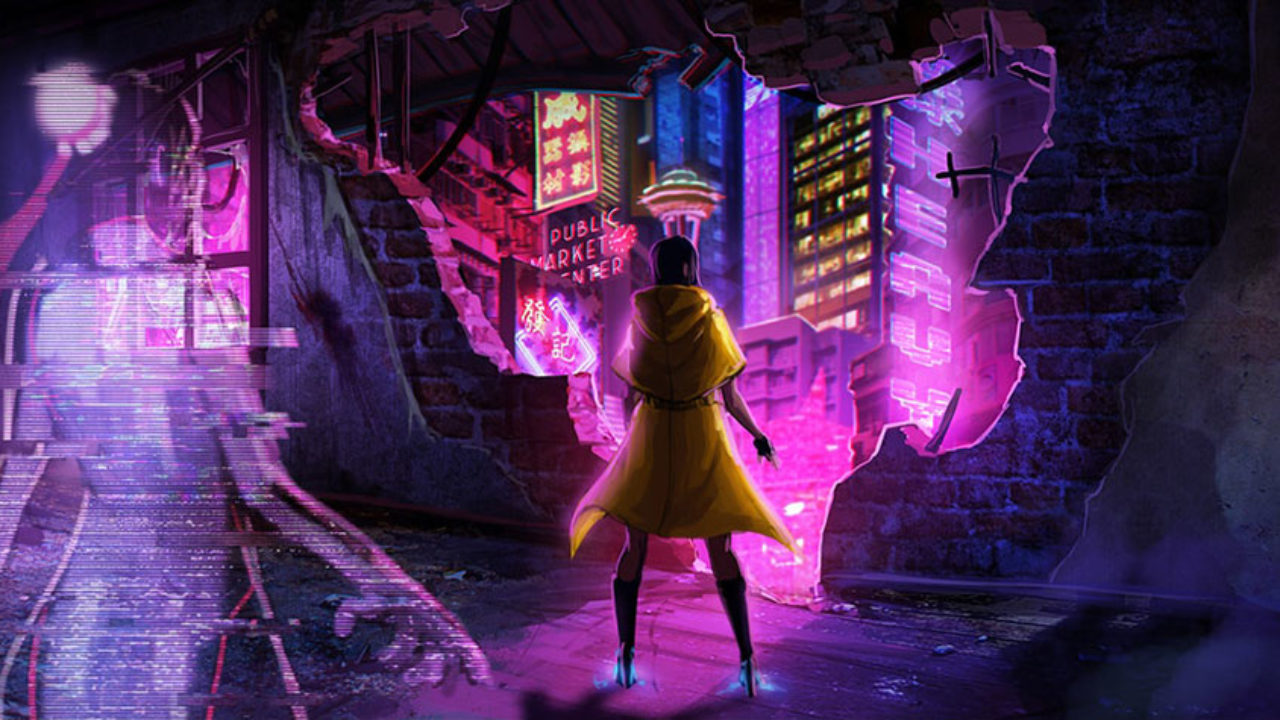
COMMENTS
Pre-ordered from playasia https://www.play-asia.com/sense-a-cyberpunk-ghost-story-limited-edition/13/70e2j9?tagid=1415491
The protagonist looks stupid with the giant boobs. They’re not even done well. I looked up reviews for this game because the summary sounded interesting on its store page, but seeing the main character made me think it would be one of those basement-wanking, hentai-nerd games and/or have zero substance, budget, or actual game, with the developers hoping ***BOOBIES!!!*** would sell their dollar bin, mobile-reject game. Is anyone even still into big boobs? Is it 1987 again?